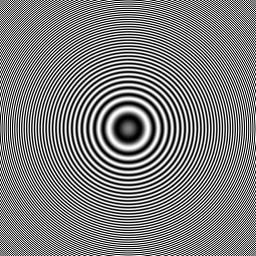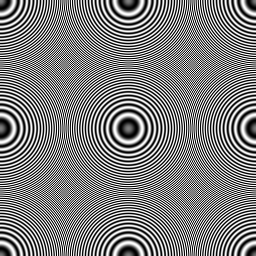Zone Plate
The circular zone plate has zero horizontal and vertical frequencies at the center. Horizontal frequencies increase as you move horizontally, and vertical frequencies increase as you move vertically.
These patterns are useful to:
- evaluate image compression
- evaluate filter properties
- evaluate the quality of resampling algorithms
- adjust gamma correction - at the proper gamma setting, the møires should be minimized
This code was written by me and Steve Gabriel from a paper published by the BBC. We also implemented the hyperbolic zone plate, which is easier to implement, but not as intuitive to use.

ZonePlate -w 256 -h 256 -o z128 -s 128 |
This one covers all representable frequencies. |

ZonePlate -w 256 -h 256 -o z256 -s 256 |
This one goes beyond the previous one until the first alias.
Note the gray vertical bands resulting from analog video signal filtering in the display system. No such filtering occurs vertically, so there are no corresponding horizontal bands. An annoying flicker appears instead on an interlaced display. |
ZonePlate.c